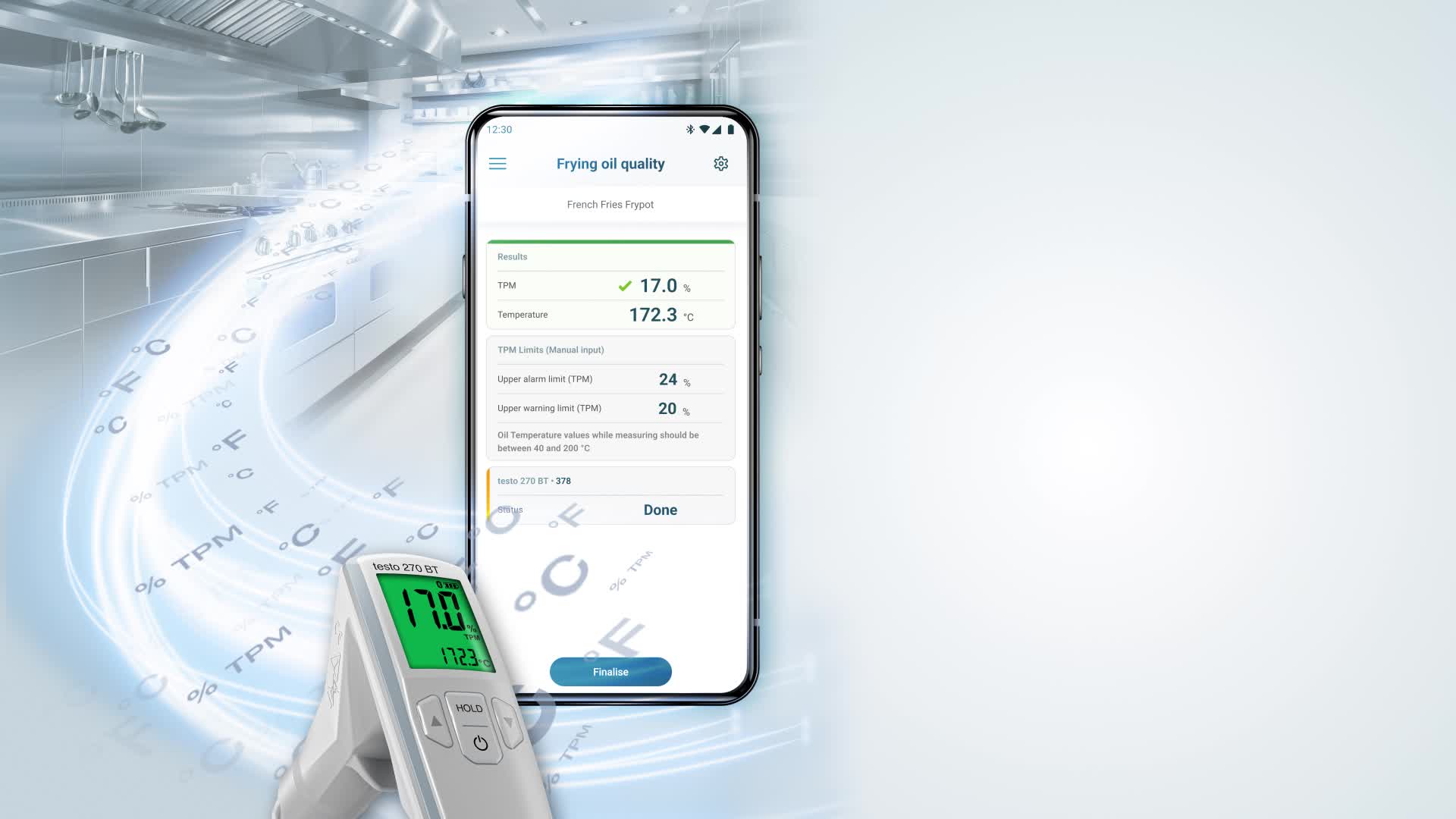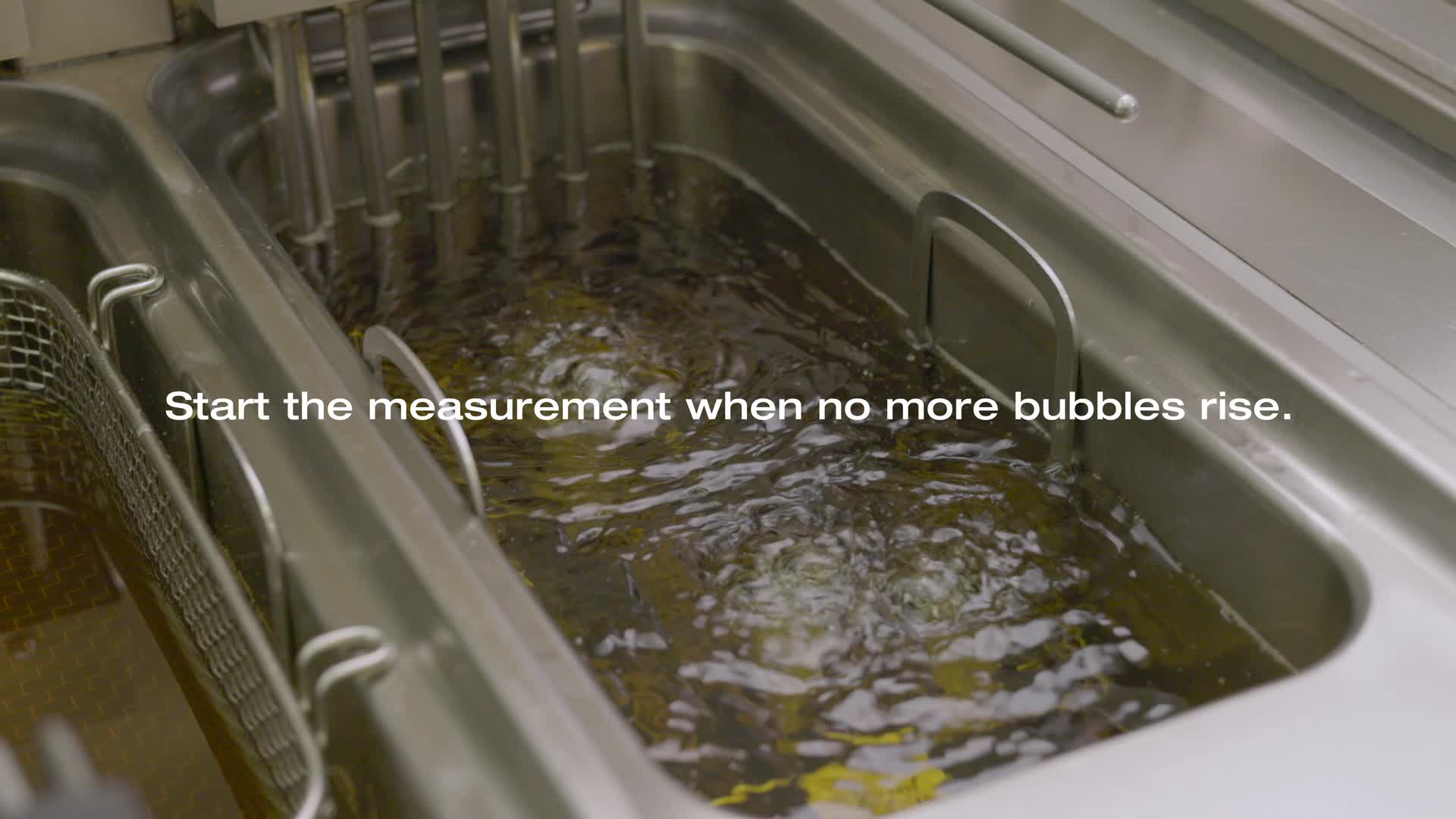Frying oil testers
Save oil and reduce costs by determining frying oil quality with a simple measurement.

Frying oil testers and accessories

Key benefits of the testo 270 BT frying oil tester
Intuitive display illumination indicator function based on the traffic light principle
Seamless app integration for error-free and digital documentation
Simple cleaning under running water in accordance with protection class IP65
HACCP and NSF-certified for maximum food safety
Areas of application of the frying oil tester
Frying oil testers play a key role in maintaining food safety, cost control and quality assurance – and are therefore used in many professional kitchens.
Areas of application
Save frying oil
Efficiently using frying oil has never been easier than with the testo 270 BT. Regular measurements enable you to determine the optimum time to change the oil and therefore prevent unnecessary wastage. Given the increased price of vegetable oil, the frying oil tester proves to be a particularly cost-effective solution when using such oil for deep frying. The testo 270 BT can help to reduce the amount of frying oil used by up to 20%, resulting in significant cost savings.
The use of frying oil measuring technology quickly pays off: the testo frying oil calculator shows you how much you could save in just a few clicks.
Holistic frying oil management for optimum quality and cost savings
Our complete solution for food safety management offers comprehensive optimisation of frying oil management. With regular filter recommendations, timely alerts when limits are exceeded and automatic plausibility checks, it ensures efficient oil monitoring. Real-time data and a user-friendly app enable proactive maintenance and immediate action to ensure quality and reduce costs.

As reliable as always.
Simpler than ever before.
The free testo Smart App, the core component of the new Food BT line from Testo, gives you full control of all the important measurement parameters associated with ensuring the safety of your food and makes them available at a glance.
Efficient. Reliable. Intuitive.

These articles might also interest you
For maximum frying oil quality and effective cost optimization
Whether crispy fries, succulent chicken nuggets or sweet doughnuts – deep-fried dishes enjoy global popularity and are an integral part of the food industry. To constantly guarantee the delicious taste, quality and safety of the fried food, regular frying oil changes are essential. If the oil is not changed soon enough, it becomes contaminated by degradation products, which can impair the taste and be harmful to health due to the formation of carcinogenic substances. On the other hand, changing the oil too soon leads to increased costs, especially when considering the high price of vegetable oil.
The testo 270 BT frying oil tester makes it possible to intuitively determine the quality of the frying oil and thus the ideal time to change it. This not only reduces the amount of frying oil used and therefore the associated costs, but also ensures the consistently delicious flavour of the fried food. Thanks to the app integration, you can seamlessly transfer your measurement results to your smartphone or tablet to ensure error-free and digital documentation.
Measurement training card
The testo Smart App – full networking. Full control.
The free testo Smart App gives you full control and an instant overview of all the important measurement parameters relating to the safety of your food. Thanks to the seamless app integration of the measuring instruments, you benefit from numerous smart functions for optimum quality management.
Efficient: fast recording as well as error-free and seamless digital documentation and Bluetooth transmission of all measurement results
Reliable: storage of the measured values and reporting with precise traceability over defined periods of time
Intuitive: simple and intuitive operation, even for less experienced or frequently changing personnel

How does the testo frying oil tester work?
Successfully measure frying oil – with the testo 270 BT frying oil tester
A visual check or sniff test alone cannot sufficiently confirm whether frying oil still offers good quality. With the testo 270 BT frying oil tester, restaurant operators only need to change the frying oil once critical TPM values are reached. This eliminates unnecessarily frequent frying oil changes and the associated costs, while ensuring consistently high quality. The integration with the testo Smart App makes the entire process even simpler and more error-resistant, plus ensures paperless documentation.
Once the fried food and any residues have been removed from the deep fryer and no further bubbles rise from the oil, this indicates that the oil no longer contains any water and the measurement can be performed accurately. Both water and food would impair the measurement.
The ideal position lies between the minimum and maximum markings on the probe, similarly to when checking the oil level in a car. At least 1 cm clearance should be retained between the probe and the deep fryer’s metal components. Make small circular movements in the frying oil to test it as it is no longer homogeneous after use.
If you use the testo 270 BT frying oil tester in Auto-Hold mode, the display will flash during the measurement. Once it stops flashing, the measured value has stabilized and the proportion of total polar materials (TPM) and temperature of the oil appear on the tester’s display. The measurement process is optimally supported by the app-based frying oil measurement programme but can also be easily performed manually without the app.
The display’s background illumination makes interpreting the TPM value particularly easy:
Green (less than 20% TPM): the oil quality is good.
Orange (between 20% and 24% TPM): the oil quality is still okay but it is advisable to change or filter the oil in the near future.
Red (over 24% TPM): the oil in the deep fryer needs to be changed.
Incidentally, frying oil develops its best potential between 14% and 20% TPM: in this range, the oil is safe and makes the fried food taste particularly delicious.
When using the testo 270 BT, you can define custom TPM limit values and pin-protect important instrument configurations to prevent accidental or undesired changes.
Purchasing criteria for a frying oil tester
In addition to measuring accuracy and robustness, you should also consider the following aspects:
The reliable and error-free documentation of measured values is a decisive criterion when purchasing a frying oil tester. A modern instrument should offer the ability to transmit measured values in digital format via Bluetooth and simply track them using an app. The testo 270 BT also offers several other functions, such as the integrated signature and comment function plus independent calibration on site using reference oil, which offer added benefits and enhanced convenience during quality controls. The automatic colour-coded depiction of the measurement results in the app is particularly practical: the measured values are interpreted in different colours based on preset limit values so that you can instantly see whether the frying oil is still usable or needs to be replaced.
A user-friendly and intuitive indicator display is essential for quickly assessing the oil quality. An instrument that visualizes the measured values on the basis of the traffic light principle – green for good quality, yellow for acceptable quality and red for oil that needs changing – enables even inexperienced personnel to instantly make correct decisions.
The safety of the operating personnel has top priority. A good frying oil tester is characterized by an ergonomic structure that enables measurements while maintaining sufficient safety clearance from the hot frying oil and a device display that can be practically viewed during measurements. This significantly reduces the risk of burns.
Hygiene is essential in the field of gastronomy. An instrument that is easy to clean and has a design that offers the required protection against water and grease (IP65) reduces cleaning times and enables simple maintenance.
Certifications from internationally recognized organizations such as HACCP (Hazard Analysis and Critical Control Points), NSF International (National Sanitation Foundation) and BVLK (Bundesverband der Lebensmittelkontrolleure Deutschlands e.V.) ensure that the frying oil tester meets strict hygiene and safety standards.

Functions of the testo frying oil tester
The testo frying oil tester was developed to perform quality controls on frying oil precisely, efficiently and safely. It combines state-of-the-art measuring technology with practical and intuitive use to enable the most important quality parameters to be determined objectively, quickly and reliably, so as to guarantee optimum frying oil quality and the best frying results.
The testo frying oil tester is a valuable instrument thanks to its user-friendly design and its robust structure.
Quick and precise measurement with or without app integration, directly in the hot oil at temperatures of between 40°C and 200°C
Error-free digital documentation via Bluetooth with a signature and comment function
Simple tracking of all measured values via the testo Smart App
Independent calibration on site (using reference oil) via the testo Smart App
Protection class IP65 for cleaning under running water
Ergonomic design for a secure grip
Impact-resistant fibreglass-reinforced housing and break-proof oil sensor
Optimize your frying processes with the new testo 270 BT and make it easier to monitor and maintain your high product quality while also reducing your oil consumption.

Test frying oil correctly
The frying oil tester offers clear advantages over conventional frying oil test strips. Not only is it more intuitive and safer to use, but it also delivers reliable and comparable results. The testo 270 BT furthermore enables simple, reliable measurements without consumables, making its usage more efficient and environmentally friendly.
With frying oil test strips, a dye is used, which changes colour on contact with the oil. The oil quality can then be assessed by comparing the colour to a table. However, frying oil test strips measure the content of free fatty acids, which can vary when deep frying, and should therefore be used with great care. On the other hand, our testo 270 BT frying oil tester enables the oil quality to be assessed with greater precision and reliability. It also features an ergonomic design that makes it easy to hold and protects you against direct contact with the hot frying oil. Furthermore, the tester can be used to perform direct measurements in hot oil at temperatures of between 40 and 200 degrees, enabling you to determine the oil’s temperature at the same time.

Other Testo measuring instruments


Frequently asked questions
Do you have any questions? We have the answers! Our FAQs provide useful responses to the most common questions about frying oil quality and our products.
To safely and precisely test the quality of frying oil, we recommend the easy-to-use testo 270 BT frying oil tester.
Remove the fried food and wait until no more bubbles can be seen in the oil.
Switch on the frying oil tester.
Immerse the frying oil tester in the hot oil and perform the measurement. The app-based frying oil measurement programme supports you during the measurement process, but the measurements can also be performed manually without the app.
Directly read the TPM value on the display. Thanks to integration with the testo Smart App, you can keep a constant eye on the TPM values of your frying oil and conveniently monitor and analyze all relevant data on your mobile device. Instant notifications and recommendations based on your TPM measurements help you optimize the oil quality. The colour-coded display illumination clearly indicates the condition of the oil: green for a healthy TPM content, orange for a critical value and red for exceeded limit values.
The shelf life of frying oil varies depending on the oil used and the frequency of frying. To ensure that the frying oil is always of optimum quality, the regular use of a frying oil tester is recommended. This enables you to quickly test the oil quality and ensure safe frying. Depending on how much the deep fryer is used, it can be useful to initially monitor the quality daily and then adapt the test intervals.
To maximize the shelf life of the frying oil, this should be filtered after every use and the deep fryer should be covered over when not in use. The oil should also be stored in a cool, dark place. Despite efforts to maximize the shelf life of the frying oil, please note that it will not last forever. If any signs of quality defects arise, the frying oil should therefore be changed for health reasons.
The amount of time for which frying oil can be used varies depending on the quality of the oil, the type of food fried and the temperature when frying. As a general rule, frying oil can be reused up to five times as long as it does not show any signs of deterioration. There are several natural signs of when it is time to change the frying oil:
Dark discolouration or loss of clarity
Rancid or unpleasant odour
Smoke formation prior to reaching the desired temperature
Unusual taste or texture of the fried food
To minimize all risks, we recommend using a frying oil tester. This useful instrument makes it possible to monitor the condition of the frying oil and therefore determine the optimum time to change it. This kind of oil tester can be extremely beneficial when it comes to constantly guaranteeing the quality of the oil.
For companies in the food industry, frying oil is often an unavoidable side product of their everyday activities. However, improperly disposing of the oil from deep fryers can have severe environmental consequences.
Oil contains saturated fats, pollutants and food residues that can negatively affect the environment if disposed of improperly. For example, if oil from deep frying gets into drains, it can cause blockages that damage both your company and the environment. Improper disposal methods can also cause soil and water pollution and pose risks to local animals and plant life.
There are various safe and environmentally conscious ways of disposing of oil from deep frying.
Professional disposal services: companies that have specialized in the disposal of frying oil can be found in many regions. These providers are familiar with local regulations and recycle oil in an environmentally friendly manner. It is worth researching such services carefully and choosing ones that demonstrably use environmentally friendly methods.
Cooperation with biodiesel producers: some companies, such as producers of biodiesel, may be interested in used frying oil. These recycle the oil to produce biodiesel, which can be used as a sustainable alternative to conventional fuel. Cooperation with such companies can be an ecologically sound solution for both your company and the environment.
Waste separation and disposal: to make it easier to dispose of frying oil, companies can equip their premises with suitable collection containers. These should be securely and tightly sealed to prevent leaks. The collected oil can then be picked up by authorized disposal services and duly recycled.
























































